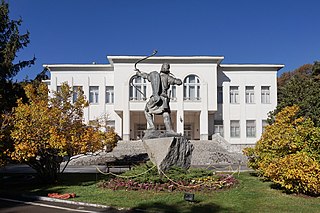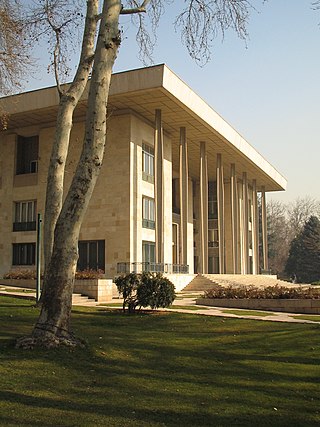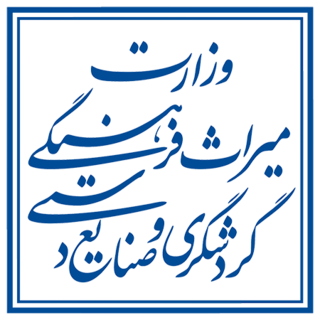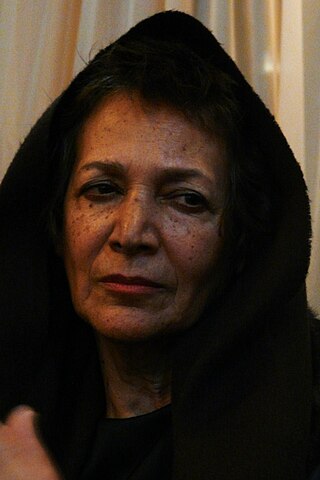
Tehran is the capital and largest city of Iran and also the largest city in Tehran Province. It also serves as the capital of the province, county and the Central District. With a population of around 9.4 million in the city, and 16.8 million in the metropolitan area, Tehran is the most populous city in Iran and Western Asia, the second-largest metropolitan area in the Middle East after Cairo, and the 24th most populous metropolitan area in the world. Greater Tehran includes several municipalities, including "New Town of Andisheh", "Islam Shahr", "Shahreh Qods", "Shahryar", "Pakdasht" and "Shamiran".

The Golestan Palace, also transliterated as the Gulistan Palace and sometimes translated as the Rose Garden Palace from Persian language, was built in the 16th century, renovated in the 18th century and finally rebuilt in 1865. It is the former official royal Qajar complex in Tehran.

The Sa'dabad Complex is a 110 hectare complex built by the Qajar and Pahlavi monarchs, located in Shemiran, Greater Tehran, Iran. Today, the official residence of the President of Iran is located adjacent to the complex.

The Niavaran Palace Complex is a historical palace complex situated in Shemiran, Iran. It consists of several palace buildings and monuments dating back to the Qajar and Pahlavi eras.

The National Museum of Iran is located in Tehran, Iran. It is an institution formed of two museums; the Museum of Ancient Iran and the Museum of the Islamic Era, which were opened in 1937 and 1972, respectively. The institution hosts historical monuments dating back through preserved ancient and medieval Iranian antiquities. It also includes a number of research departments, categorized by different historical periods and archaeological topics. National Museum of Iran is the world's most important museum in terms of preservation, display and research of archaeological collections of Iran, and currently displays works that express the richness of history, culture, civilization, art, economic growth and technological achievements of Iran.

Valiasr Street, formerly known as the Pahlavi Street, is a tree-lined street in Tehran, dividing the metropolis into western and eastern parts which were built in 1922 to 1927 respectively, considering the end of asphalt plan it ended in 1933. It is considered one of Tehran's main thoroughfares and commercial centers. It is also the longest street in the Middle East, and was reported as one of the longest in the world by former BBC journalist Rageh Omaar during the television documentary Welcome to Tehran.

The Marble Throne is a 250-year-old royal throne in Golestan Palace, Tehran, Iran.

Jannat Abad is a large neighbourhood in Tehran, Iran. It is an area around the Jannat Abad Street located in North West Tehran. Jannat Abad street starts from Ayatollah Kashani Freeway. It has several squares. The most famous one is Chahar Bagh. Jannat Abad Blvd has a South segment that is below the cross with Hemmat Freeway and North part that is located upon Hemmat and links to the Marzdaran Freeway.

Pearl Palace, also known as Shams Palace is an estate in Iran, designed by Taliesin Associated Architects on instructions from princess Shams Pahlavi, elder sister of Mohammad Reza Pahlavi, the last Shah of Iran. It was built in the early 1970s and is located in the Mehrshahr neighborhood, in Karaj City, Iran.

The Ministry of Cultural Heritage, Tourism and Handicrafts of Iran is an educational and research institution overseeing numerous associated museum complexes throughout Iran. It is administered and funded by the Government of Iran. It was first established in 1985 by legislation from the Majlis merging 11 research and cultural organizations. In 2019, the Iranian Cultural Heritage, Handicrafts and Tourism Organization (ICHHTO) was converted into the Ministry. The current Minister is Ezzatollah Zarghami, being appointed 25 August 2021 by Ebrahim Raisi.

Maryam Zandi is an Iranian documentary photographer and author. She is best known for her photographs during the Iranian Revolution.
Gholhak or Qolhak is a neighborhood located in District 3 of Tehran Municipality. It is bounded on the east by the Darrous neighborhood, on the west by the Gholhak River, on the north by the British Embassy Garden, and on the south by the Pourmeshkani Street and Zafar Street (Dastgerdi).

Farideh Lashai was an Iranian painter, printmaker, video artist, and translator. She was also a writer and translator. Her foremost book is Shal Bamu. She is renowned for her abstract contemporary paintings, which are a combination of traditional and contemporary views of nature.
Shahr-e No was the red light district located in Gomrok, a south-western district of Tehran, Iran. It appeared in the 1920s and was destroyed in 1979; it employed about 1,500 women. Its location is now occupied by a park and a hospital.

The Takyeh Dowlat was a royal theater in Tehran, Iran. It was the most famous of all the ta'zieh performance spaces, for the Mourning of Muharram. It had a capacity for more than 4,000 people. Built in 1868 by Naser al-Din Shah Qajar south-east of the Golestan Palace on the site of the Síyáh-Chál, the royal theater's sumptuous magnificence surpassed that of Europe's greatest opera houses in the opinion of many Western visitors. Samuel Greene Wheeler Benjamin said on his first visit that it was comparable to Verona Arena.

The Marble Palace is an historic building and former royal residence in Tehran, Iran. It is located in the city centre, but the location was a quiet quarter of Tehran when the palace was erected.

Abu'l-Hasan Khan Ghaffari Kashani was an Iranian painter, miniature and lacquer artist, and book illustrator. When he became the Chief Court Painter, he also became known as Sani al-Mulk (صنیعالملک), meaning "The Crafter of the Kingdom." He was a student of Mihr Ali and a court painter in Mohammad Shah Qajar's court. After being dismissed as a court painter, he went to Europe to study, most notably in Italy. When he returned to Iran, he became the Director of Printing and Chief Illustrator for Nasir al-Din Shah and earned the separate title Chief Court Painter. He supervised the illustration of a famous One Thousand and One Nights manuscript, which can be viewed today in Tehran in the Golestan Palace Library.

The Glassware and Ceramic Museum of Iran or simply Abgineh Museum is located at 30 Tir Street, in Tehran, Iran. It was private residence of longtime Prime Minister Ahmad Qavam from 1921 until 1951. The complex was also Embassy of Egypt for seven years.

The Museum of Ancient Iran is located at the western part of Mashhq Square in Tehran, Iran. It was designed by André Godard by the order of Ali-Asghar Hekmat, then Minister of Education of Pahlavi Iran. Two Iranian master builders, Ostad Morad Tabrizi and Abbas Ali Memar, constructed the building. Construction of the museum was started in 1934 and was completed in 1937. It was subsequently opened for the public.

Shams-ol-Emareh is one of Tehran’s historical buildings and a remnant of Qajar Persia. It is one of the most prominent buildings on the east side of Golestan Palace. It was built in 1865-1867. It is notable for its height, decorations and design.





















